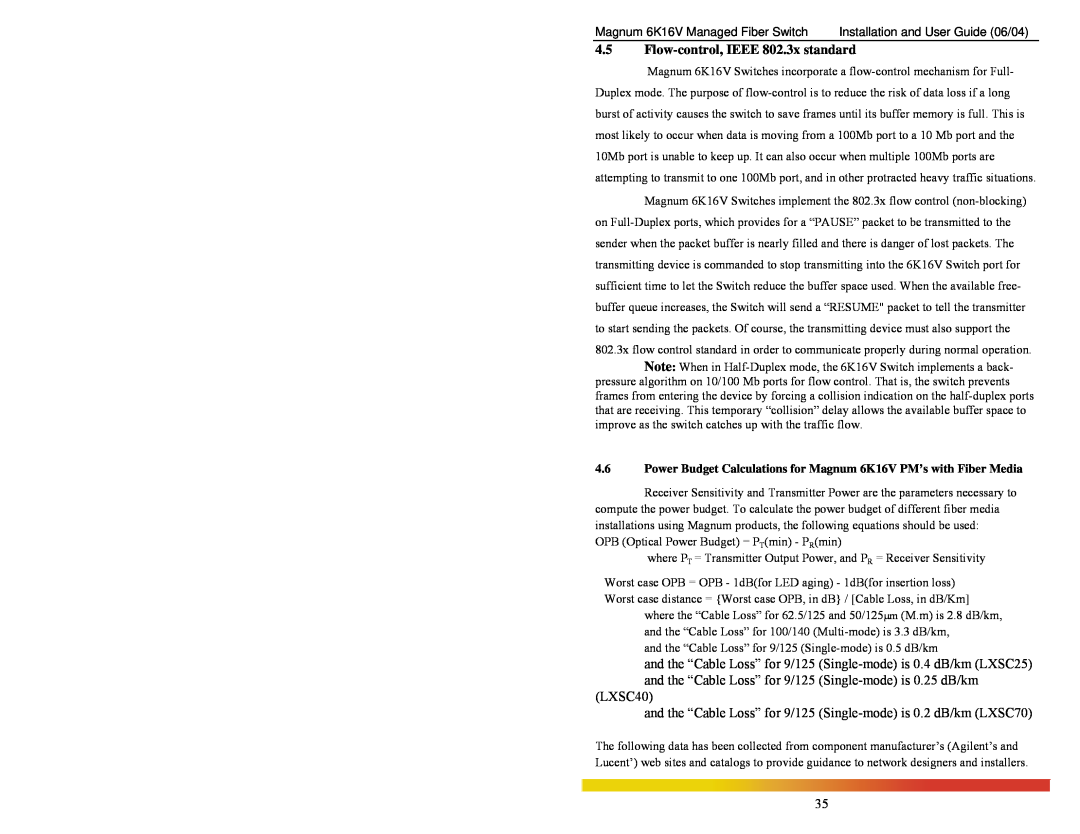Installation and User Guide
www . GarrettCom . com
Managed Fiber Switch
Hardware
Magnum 6K16V Managed Fiber Switch Hardware
Installation and User Guide
Trademarks
Radio Frequency Interference Statement
Contacting GarrettCom, Inc
Federal Communications Commission
Reorient or relocate the receiving antenna
Introduction
SPECIFICATIONS
Installation
OPERATION
APPENDIX A WARRANTY INFORMATION
5.0 Introduction - Magnum 6K16V Managed Fiber Switch PM
TROUBLESHOOTING
APPENDIX B Internal DC Power Supply Options
“OUTDOOR” ETHERNET SWITCH, FOR TEMPERATURE
6K-SERIES MANAGED FIBER SWITCHES, GIGABIT, 100 AND
QUAD-SERIES FIBER SWITCHES, 100 & 10MBPS, FIBER AND
PERSONAL SWITCHES, 10/100MB
TRANSCEIVERS, 10MB SERIES MINI-TRANSCEIVERS AND COAX
MEDIA CONVERTERS, 10MB AND 100MB SERIES
BRIDGE PORT MODULES BPMS, 4 TYPES, FOR SEGMENT
MODELS
Performance
1.0 SPECIFICATIONS 1.1 Technical Specifications
Fiber Multi-mode connector types supported
Network Standards and Compliance, hardware
Management Console connector
Fiber Single-mode connector types
Alarm Relay Contacts
Power Supply Internal
NEBS Test Classification NEBS Compliant
Per-port jumpers and switches
Agency Approvals
Email sales@GarrettCom.com for details
MODEL DESCRIPTION
Magnum Managed Fiber Switch 16 ports max
Configuration Options
1.2 Ordering Information
fiber ports connector
2.0 Introduction 2.1 Inspecting the Package and Product
2.2 Product Description - Magnum 6K16V Managed Fiber Switch
Fig.2.2.2 SFF Fiber Port Modules 6K8-MTRJ to the left and
100Mb, mode, and connector
2.2.1 Eight-port SFF fiber modules 6K8-MTRJ, 6K8-MLC, 100Mb fiber
6K8-MLC or -SLC below
2.2.2 Eight-Port Copper Module, 6K8-RJ45
six-port modules are also available
4@ RJ-45 + 2@ 100Mb SC
The Magnum Combo
with 4@ MTRJ 100Mb mm SFF
1@ 1000Mb Fiber SC + 2@ 100Mb SC
2.2.4 Four-Port 10 Mb and 100Mb mm Fiber ST Modules
2.2.6 Gigabit 1000Mbps port modules
1@ 1000Mb Fiber SC + 4@10/ 100Mb
2.2.6 Packet Prioritization, 802.1p QOS
2.2.7 Frame Buffering and Flow Control
2.2.8 Managed Network Software MNS-6K for Magnum 6K16V
ftp//ftp.garrettcom.com
„ Switching services includes 802.1p QoS packet prioritization
2.3 Features and Benefits
„ Managed switching for high performance Ethernet LANs
„ Features Fiber-Built-In
Example 1 Magnum 6K16V Switch for a Industrial application
2.4 Applications
Fig. 2.1- The Industrial factory floor application with Magnum 6K16V
Internet
SNMP Monitor
3.0 Installation
3.1 Locating Magnum 6K16V Switches
3.2 Connecting Ethernet Media
3.2.3 Connecting Single-Mode Fiber Optic
3.2.1 Connecting Fiber Optic ST-type, “twist-lock”
3.2.2 Connecting Fiber Optic SC-type, Snap-In
IEEE Standard
3.2.5 Connecting Twisted Pair CAT5E or better, Unshielded or Shielded
Media
3.2.6 Connecting Gigabit Media Using GBICs
3.3 DIN-Rail Mounting
3.3.1 Mounting Dimensions for 6K16V with metal brackets
3.4 Powering the Magnum 6K16V Managed Fiber Switch
3.5 Alarm Contacts for monitoring internal power, and Software Traps
Relay Contacts
Be sure the power cord is unplugged
3.6 6K16V Port Module 6KPM Installation
3.6.1 Preparation for Installing and Removing 6KPMs
and will void the warranty
Figure 3.6.1a Removing the Front panel from the unit
Caution Be careful not to disturb the power supply
Step 2. Remove Chassis Cover
Figure 3.6.1b Magnum 6K16V, Top view without chassis cover
Figure 3.6.1c Top View - 6KPM retaining screws hold Face Plate
3.6.2 Installing 6KPM Cards in the Magnum 6K16V
Step 3. Remove front panel face plate retaining screws
Fig 3.6.2a Granddaughter Board shown separately
Fig. 3.6.2c Daughter Board, top view of
version for 4 copper 10/100 ports
Fig. 3.6.2g Top View 6KPM Module installed inside a 6K16V
Figure 3.6.2f Securely latching up 6KPM Cards into a Magnum 6K16V
firmly. Figure 3.6.3a Top View - 6 retaining s crews shown by arrows
Caution Be sure the power cord is unplugged
3.6.3 Removing 6KPM Cards
Step 3. Remove 6KPM Card
3.7.1 RS-232 DB-9 Console Com port Serial port pin assignments
3.7 Connecting a Management Console Terminal to Magnum 6K16V
DB-9 Console port connector
Enlarged view of Magnum 6K16V Console Port area
Filtering and Forwarding
4.1 Switching Functionality
4.0 OPERATION
Address Learning
Full / Half duplex LED, ON when the port is running full
4.3 Up-link Manual Switches set as = , for RJ-45 port only
Power LED, ON when external power is applied to the unit
Speed LED, ON when the speed is 100Mbps , OFF when the
Auto-negotiation per-port for 802.3u-compliant switches occurs when
4.6 Power Budget Calculations for Magnum 6K16V PM’s with Fiber Media
4.5 Flow-control, IEEE 802.3x standard
LXSC40 and the “Cable Loss” for 9/125 Single-mode is 0.2 dB/km LXSC70
6KP4V
Magnum 6K16V Managed Fiber Switch
Installation and User Guide 06/04
Km, fdx
5.0 Introduction - Magnum 6K16V Managed Fiber Switch Port Modules
5.1 Inspecting the Package and Product
5.2 6KPM Module Description
5.2.1b 6KP4-F10ST, 4@10Mb multi-mode FX-ST “twist lock” Module
Half-duplex by default
ports are ST connectors
and configured as 10Mb
connectors and configured
The Magnum 6KP6
mode SC-type connectors. It
module of the 6K16V Switch
RJMSC is also a Combo 6 Port
as 25+ Km see Power Budget, Section
The functionality of this 100BASE-FX multi-mode 4 port module is
“small-form-factor”
5.2.5 6KP8-MTRJ, 8 @100Mb multi-mode FX , MTRJ Small-Form-factor
6KP8-MTRJ
MTRJ Small-Form-Factor
MTRJ connectors give an advantage
5.2.6 6KP8-45MT, 4@ 10/100Mbps RJ-45 and 4@100Mb multi-mode FX
The Magnum 6KP8-45MT
5.2.9 6KP8-RJ45 Twisted Pair, 10/100Mb 8-Port
connecting to a hub or another switch
5.2.11 GBIC-SXSC Gigabit fiber1000Mb, multi-mode SC Connector
6KP8V
Single-Mode Fiber port LC
5.2.11a GBIC-LXSC Gigabit fiber 1000Mb, multi-mode SC Connector
5.2.12 6KM-BLNK
6.0 TROUBLESHOOTING
6.1 Before Calling for Assistance
6.2 When Calling for Assistance
6.3 Return Material Authorization RMA Procedure
No Problem Found
GarrettCom, Inc 213 Hammond Ave Fremont, CA Attn. Customer Service
6.4 Shipping and Packaging Information
B1.0 SPECIFICATIONS FOR MAGNUM 6K16V SWITCHES, DC POWER
B2.0 -48VDC, 24VDC and 125VDC POWER, THEORY OF OPERATION
B3.0 APPLICATIONS FOR DC POWERED ETHERNET SWITCHES
B4.0 6K16V’S -48V, 24, 125 OR 5VDC INSTALLATION
hooked up at the last
B4.1 UL Requirements for DC-powered units
B7.0 TROUBLESHOOTING
B5.0 OPERATION
Power Supply Internal, 24VDC Dual-Source, model # Dual-Src-24V
Power Supply Internal, 125VDC Dual-Source, model # Dual-Src-125V
C3.0 DUAL-SOURCE OPTION, THEORY OF OPERATION
C4.0 FEATURES AND BENEFITS OF THE DUAL-SOURCE DESIGN
C5.0 INSTALLATION
Example Magnum 6K16VR-48VDC
C5.1 UL Requirements
C6.0 ORDERING INFORMATION
C7.0 OPERATION
